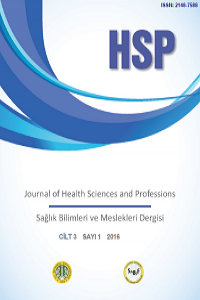Abstract
Amaç:Bu araştırma, hemşirelik öğrencilerinin eleştirel düşünme düzeylerini ve hemşirelik eğitiminin öğrencilerin eleştirel düşünme düzeyine etkisini belirlemek amacıyla gerçekleştirilmiştir.
Yöntem: Tanımlayıcı tipte olan araştırma Tekirdağ ilindeki bir devlet üniversitesinin Sağlık Yüksekokulu Hemşirelik Bölümü’nde gerçekleştirilmiştir. Araştırma 2013-2014 eğitim-öğretim yılı bahar döneminde, ilk ve son sınıfta öğrenimlerini sürdüren ve araştırmaya katılmayı kabul eden öğrenciler ile yürütülmüştür. Birinci ve son sınıftaki toplam 210 öğrenciden 160’ı araştırmada yer almıştır. Veriler Kişisel Bilgi Formu ve Kaliforniya Eleştirel Düşünme Eğilimi Ölçeği (KEDEÖ) kullanılarak toplanmıştır. Veriler tanımlayıcı (ortalama, standart sapma, yüzdelik hesapları) ve karşılaştırmalı (Mann Whitney U testi, Kruskal Wallis) istatistiksel araştırma yöntemleri kullanılarak analiz edilmiştir.
Bulgular: Hemşirelik öğrencilerinin eleştirel düşünme puan ortalaması (252.50±28.96) hesaplanmış olup, orta düzeyde olarak değerlendirilmiştir. Öğrencilerin KEDEÖ alt boyut puan ortalamaları arasında en yüksek puanı analitik düşünce alt boyutundan (46.03±7.13), en düşük puanı ise doğruyu arama alt boyutundan (37.36±6.90) aldığı belirlenmiştir. Araştırmada öğrencinin devam ettiği sınıfın, mezun olduğu okulun, anne eğitiminin, gelir düzeyinin ve aile yapısının öğrencilerin eleştirel düşünme düzeylerini etkilediği saptanmıştır.
Sonuç: Eleştirel düşünme düzeyleri orta düzeyde bulunan hemşirelik öğrencilerinin öğrenimleri süresince eleştirel düşünme becerilerini geliştirecek şekilde desteklenmesi gerekmektedir.
First and Last Grade Nursing Students' Levels of Critical Thinking and
Affecting Factors
ABSTRACT
Aim: This study was conducted to determine the level of critical thinking and the factors affecting critical thinking of the fırst and last grade nursing students.
Method: This descriptive study, School of Health of Nursing Department was carried out at a state university. This study was carried out with first and last grade students that might have the most different levels of critical thinking in 2013-2014 academic years’ spring semester. A total of 210 students from 160 of the first and the last grade students who accepted to participate in the study. Data of research was collected by using Personal Information Form and California Critical Thinking Disposition Inventory (CCTDI). The data were analyzed using by descriptive (mean, standard deviation, percentage) and comparative statistical tests (Mann-Whitney U Test and Kruskal Wallis Test).
Results: The mean score of critical thinking of nursing students is calculated 252.50±28.96, CCTDI subscale scores between the highest mean scores of students from analytical thinking subscale (46.03±7.13), while the lowest score from the right call subscale (37.36±6.90) was determined. Students in the class of continued, the school graduation of students’, mother's education, income level and family structure has been found to affect the level of critical thinking of students'.
Conclusion: Moderate levels of critical thinking in nursing students during their education must be supported to develop critical thinking skills. İt is important that active learning environment be established, necessary guidance be made by supporting qualified inquiries and interrogation, and the development of critical thinking be supported.
Key Words: Critical thinking, nursing education, nursing students
Atıf: Bilgiç Ş, Kurtuluş Tosun Z. Birinci ve Son Sınıf Hemşirelik Öğrencilerinde Eleştirel Düşünme ve Etkileyen Faktörler. HSP 2016;3(1):39-47.
To cite this article: Bilgiç Ş, Kurtuluş Tosun Z. First and Last Grade Nursing Students' Levels of Critical Thinking and Affecting Factors. HSP 2016;3(1):39-47.
Details
| Primary Language | Turkish |
|---|---|
| Journal Section | RESEARCH ARTICLE |
| Authors | |
| Publication Date | January 14, 2016 |
| Published in Issue | Year 2016 Volume: 3 Issue: 1 |


